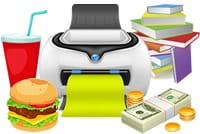You’ve figured out how to cover the cost of tuition and room and board, and you think to yourself, “Now I can coast through the school year on a small budget.” Think again. College costs can continue to add up. Here are some things you may not have considered.
Text Books
Don’t underestimate the cost of books. This is not high school. They don’t come free with the course.
It’s not unheard of for a text book to cost $300 new. Some courses require multiple books. Multiply that by 5 classes and you’ve got a big dent in your budget. If you want to save time, you can buy your books at the college book store. If you want to save money, do your shopping ahead of time and try these options:
- Buy Used. You can find used text books on Amazon, Barnes & Noble, and eBay. Not to mention, online stores like ecampus.com, and bookbyte.com.
- Rent. If you know you’ll never open the book again once class is over, you can rent from websites such as bookrent, bookrenter.com or chegg.com.
If you do rent or buy used, double-check your course requirements and the ISBN number to make sure you get the right edition of the book.
Do you need a printer?
Even though a few courses will be (mostly) paperless, you should plan on having to print some of your course work. But, you don’t have to buy a printer, because most colleges have printers for campus use. (Check with your college).
However, you may want a printer if you’re the type who does homework at the last minute, or if you’re taking courses that require a lot of writing. Let’s compare your options:
- Using the campus printers: There may be a charge per page, but it’s usually pennies. Compare that to the cost of buying your own printer, paper and toner.
- Using your own printer: If this is the option that works best for you, you’ll want to find good deals on paper and toner. Consider buying paper by the box and using recycled toner cartridges.
Meals and Snacks
Cafeteria meal plans. Colleges usually offer multiple meal plans. You can have 3 meals a day 7-days a week, or you can have a plan that covers lunch and dinner but not breakfast, or weekdays but not weekends. You need to choose a plan that fits your course schedule and weekend plans.
Snacks and food in the dorm room. Many college students feel that a small fridge, popcorn air-popper, and coffee-maker are essential. Check with the college to see what types of appliances are allowed in the dorms. If keeping simple foods in your room is part of your budget strategy, you’ll need to have cash and access to a grocery store to keep your fridge stocked.
Consider your class schedule. This is especially important if the cafeteria isn’t open all day. Will you miss an important meal each day if the cafeteria is only open from 7am-9am, 11am-2pm, and 4-7pm? That could make the small fridge in your dorm an essential instead of a luxury.
The cost of books, paper, toner and food can really add up. Thinking ahead will save you money.

Leave a Reply